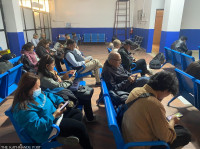Money
Nepal Bankers Association moves to reduce interest rate on loans
The association says that the cap in premium rate will provide some relief to the creditors as it reduces lending rates.
Krishana Prasain
Nepal Bankers Association on Thursday decided to cap the interest rate on loans, a move they said would protect consumers from excessive interest rates and make taking loans more affordable.
“We have decided to reduce the premium rate on loans to 5 percent from 6 percent. It will help in the reduction of the interest rates on loans,” said Sunil KC, president of the association.
Now any type of loan won’t go beyond the 5 percent base rate, he said.
“We have also reduced the interest rate on saving accounts and call deposits by 0.42 percent. The interest rate on fixed deposits of individuals has been kept at 11 percent,” KC said.
The revised interest rates will be effective from March 15, according to the association.
“With this move, there is a possibility of the lending interest rates going down as the banks had reduced the depositor’s interest rates by 1 percent, two months ago,” said Upendra Prasad Poudyal, chairman of Nabil Bank.
He said that the cap in base rate will provide some relief to the creditors. “The banks have been gradually reducing the interest rates as the liquidity crisis has eased slightly,” said Poudyal.
The banks reduced the interest rate by 1 percent on the fixed deposits that came into effect from January 15.
Nepal Rastra Bank, through its mid-term monetary policy review on February 10, continued its tighter monetary policy aimed at controlling credit expansion on fears that easy availability of credit could fuel imports, leading to a rapid depletion of its foreign exchange reserves.
In order to ensure a tighter monetary policy, the central bank kept several rates unchanged.
For example, it kept the cash reserve ratio (CRR), a certain percentage of a bank's total deposits that it needs to maintain as liquid cash at Nepal Rastra Bank, unchanged at 4 percent.
Likewise, the statutory liquidity ratio (SLR), which is the minimum percentage of deposits that a commercial bank needs to maintain in the form of liquid cash, gold or other securities, was also kept unchanged at 12 percent.
The central bank also kept the targets for credit expansion to the private sector and money supply target unchanged at 12.6 percent and 12 percent respectively, which were reduced sharply through the monetary policy.
The central bank believes cheap credit – made available to the private sector in the last fiscal year through refinancing facilities – was used in imports, which resulted in a massive deficit in the balance of payments.
The rise in interest rates made depositors happy, but businesses were upset.
Last November, members of the business community took to the streets to express their displeasure at the high interest rates charged by the banks and financial institutions.
Demonstrators associated with the Kathmandu, Bhaktapur and Lalitpur chapters of the Federation of Nepalese Chambers of Commerce and Industry, Nepal Wool Felt Producers and Exporters' Association and Woollen Felt Producers and Exporters Association, among others, staged a sit-in protest at Maitighar Mandala in Kathmandu, complaining that the banks were charging exorbitant interest rates.
The protests subsequently spread across the country. Businessmen said they were hit hard after banks jacked up the interest rate three times in a year.
The International Monetary Fund (IMF) has also flagged concerns about large boom-bust credit cycles in Nepal’s financial sector. This means credit may have grown to excessive levels and borrowers' repayment capacity eroded due to higher lending rates.
“Bank asset quality has deteriorated, reflecting a decline in the repayment capacity of borrowers due to higher lending rates and rising leverage, a concern that is moderated by banks’ capital-adequacy ratios,” according to the IMF.
The IMF said Nepal’s monetary policy should focus on maintaining a cautious and data-driven stance, supported by macroprudential measures. “This will help avoid large boom-bust credit cycles, which can create financial sector instability and are not supportive of sustainable growth.”
It also said that Nepal Rastra Bank needs to ensure appropriate re-classification of loans and closely monitor the impact of a potential deterioration in the repayment capacity of borrowers.
This story has been edited for clarity.




 7.12°C Kathmandu
7.12°C Kathmandu













